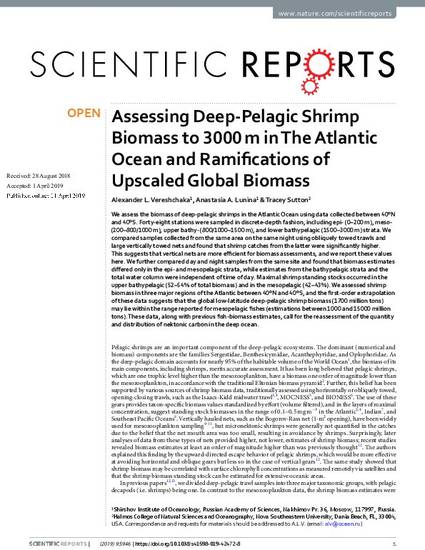
We assess the biomass of deep-pelagic shrimps in the Atlantic Ocean using data collected between 40°N and 40°S. Forty-eight stations were sampled in discrete-depth fashion, including epi- (0–200 m), meso- (200–800/1000 m), upper bathy- (800/1000–1500 m), and lower bathypelagic (1500–3000 m) strata. We compared samples collected from the same area on the same night using obliquely towed trawls and large vertically towed nets and found that shrimp catches from the latter were significantly higher. This suggests that vertical nets are more efficient for biomass assessments, and we report these values here. We further compared day and night samples from the same site and found that biomass estimates differed only in the epi- and mesopelagic strata, while estimates from the bathypelagic strata and the total water column were independent of time of day. Maximal shrimp standing stocks occurred in the upper bathypelagic (52–54% of total biomass) and in the mesopelagic (42–43%). We assessed shrimp biomass in three major regions of the Atlantic between 40°N and 40°S, and the first-order extrapolation of these data suggests that the global low-latitude deep-pelagic shrimp biomass (1700 million tons) may lie within the range reported for mesopelagic fishes (estimations between 1000 and 15000 million tons). These data, along with previous fish-biomass estimates, call for the reassessment of the quantity and distribution of nektonic carbon in the deep ocean.
Available at: http://works.bepress.com/tracey-sutton/218/

©The Author(s) 2019. Open Access. This article is licensed under a Creative Commons Attribution 4.0 International License, which permits use, sharing, adaptation, distribution and reproduction in any medium or format, as long as you give appropriate credit to the original author(s) and the source, provide a link to the Creative Commons license, and indicate if changes were made. The images or other third party material in this article are included in the article’s Creative Commons license, unless indicated otherwise in a credit line to the material. If material is not included in the article’s Creative Commons license and your intended use is not permitted by statutory regulation or exceeds the permitted use, you will need to obtain permission directly from the copyright holder. To view a copy of this license, visit http://creativecommons.org/licenses/by/4.0/.